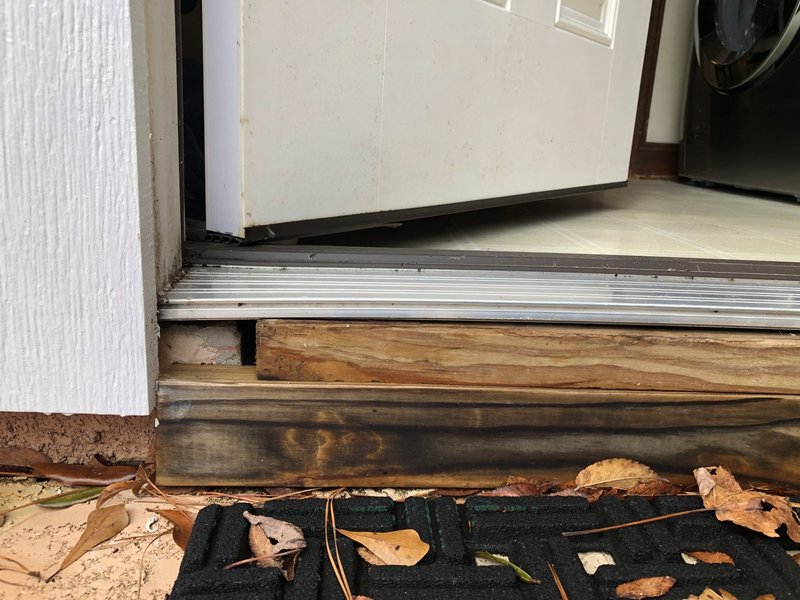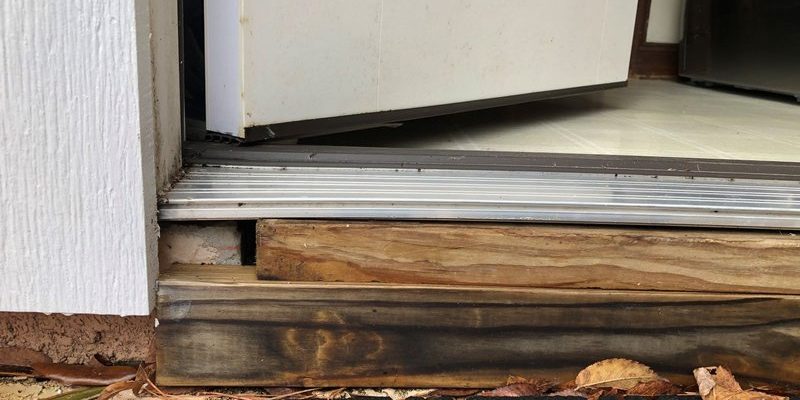
Thresholds—like the classic Schlage or M-D Building Products aluminum models—are more than just a strip under your door. They shield against drafts, keep out rain, and finish off your entryway. But being in the line of fire means they’re the first to show wear and tear. Wondering why your threshold looks like it’s aged a decade overnight, and if there’s any hope for bringing it back? Let’s walk through what’s really happening, and exactly how to clean, restore, and protect that well-worn entry.
What Causes Thresholds to Look Worn and Faded?
Let me explain: your threshold sits at the literal crossroads of the elements and your home. Every time someone crosses the doorway, they’re dragging dust, grit, water, and sometimes even road salt right over it. Dirt acts like sandpaper, slowly grinding away at the finish or paint. And it doesn’t stop there.
- Sun exposure: If your threshold gets any sunlight, UV rays will break down paint, wood sealant, or the finish on metal, leaving colors dull and fading spots unevenly.
- Moisture: Water from rain, snow, or just everyday traffic tracking in wet shoes can warp wood, cause paint to peel, or make metal thresholds start to corrode and lose their shine.
- Foot traffic: This is a big one. Think about how many shoes, paws, and even the occasional moving box slide over that small strip. Scratching and denting add up fast, even on industrial metal like what you find on more premium Schlage thresholds.
It’s sort of like owning a white couch in a busy house: no matter how careful you are, it’s going to show life’s messes sooner or later.
How to Clean a Worn and Faded Threshold
The good news: you don’t need superpowers to make a threshold look presentable again. Most of the time, a bit of elbow grease and the right cleaning approach will go a long way. Here’s what I recommend—and yes, this works for most brands, whether you have a fancy M-D aluminum, a Lowe’s house brand, or builder-grade wood.
Step-by-step cleaning:
- Sweep or vacuum: Start by getting rid of all dirt, grit, and debris. Try to get into the crevices—dirt loves hiding there.
- Mild soapy water: Mix a few drops of dish soap in warm water. Use a soft cloth to scrub the threshold. If you have extra grime or sticky residue, let the soap sit for a minute before wiping.
- Rinse and dry: Wipe with clean water and immediately dry with a towel—especially for wood or metal types prone to water spots or swelling.
- Tough stains? For metal, a dash of vinegar and water mix handles stubborn grime (just don’t use anything too acidic on aluminum). For wood, stick to gentle cleaners—harsh chemicals could strip the finish completely.
For really grimy thresholds, it can sometimes feel like cleaning old sneakers: you won’t get them “good as new,” but you can definitely make a night-and-day difference.
Common Types of Threshold Damage (And What They Mean)
You might be wondering, does every scratch or faded spot signal a bigger problem? Not always, but it’s worth knowing what each type of damage could mean.
- Scratches and dings: These are usually from shoes, pets, or dragging something heavy. Minor surface scratches are cosmetic, but deep gouges in wood could let in water and cause rot if left untreated.
- Fading: This mostly points to sun damage or a worn protective finish. Fading is common in exposed or south-facing doors.
- Warping or swelling: Wood thresholds—and even some lower-end composite types—can soak up moisture, leading to swelling or even cracks at the edges. This means moisture is getting through and a new seal or even a replacement might be needed.
- Corrosion: Metal thresholds sometimes develop a chalky white residue (aluminum oxidation) or rusty spots (on steel). You’ll know you have this issue if the finish wipes off or flakes away.
Honestly, the sooner you spot and tackle these problems, the better your chances of saving the threshold without a costly replacement.
Restoring Wood Thresholds: Bring Back Their Best
If you have a wood threshold—maybe oak, pine, or even bamboo—it can be restored with a bit of patience. Here’s the thing: wood takes restoration better than you might think, as long as it hasn’t been soaked or rotted through.
What you’ll need:
- Fine-grit sandpaper (220 grit is a safe bet)
- Wood cleaner or denatured alcohol
- A good-quality wood stain or oil (if you want to change or revive the color)
- Clear polyurethane for sealing
Steps to restore:
- Clean and dry: Get rid of all old dirt, and let the wood dry fully before sanding.
- Sand it down: Lightly sand the surface to smooth out scratches and remove the faded finish. Always sand with the grain, not against it.
- Clean again: Wipe away all the dust—nothing kills a finish faster than leftover sanding grit.
- Stain and seal: If you want a richer color, apply the stain evenly and let it dry. Follow with a good coat (or two) of polyurethane to protect it against future foot traffic and moisture.
Think of this as a spa day for your threshold: some scrubbing, a little exfoliation, and a nice protective treatment. It might not erase decades, but you’ll be amazed at how much fresher and richer the threshold looks.
How to Restore Metal Thresholds (Aluminum, Steel, or Brass)
Metal thresholds—like those from M-D Building Products or Schlage—are tough, but even they can lose their shine or develop dull, spotty patches. The trick with metals is to clean first, then polish and protect.
Step-by-step for aluminum or steel:
- Clean thoroughly: Use water and mild soap, then dry well. For aluminum, avoid steel wool—it scratches and can leave behind rusting particles.
- Remove oxidation: For chalky spots, use a paste of baking soda and water, rubbing gently, or a commercial aluminum cleaner. For light rust on steel, a bit of white vinegar and gentle scrubbing can help.
- Polish: Aluminum and brass benefit from a light metal polish. Rub with a soft, clean cloth until it shines.
- Protect: Some brands offer a clear spray or wax finish for extra protection. This isn’t mandatory, but it does slow down future fading.
If in doubt, check the product packaging or the brand’s site before using any cleaner—some off-the-shelf sprays can do more harm than good on certain metals.
Prevention: Keeping Your Threshold Looking Fresh
Let me be honest—no amount of deep cleaning and polishing will last forever if you’re not proactive about protection. After all, it’s like waxing your car but then parking it under a sap-dripping tree.
Here’s how to keep the “worn and faded” look at bay:
- Use doormats: Placing heavy-duty mats inside and outside the door catches the worst of the dirt and grit before it ever touches your threshold.
- Seal regularly: For wood, reapply a protective sealant every year or two. For metals, check for scratches or worn spots, and touch up as needed.
- Dry after rain: Especially for wood, always dry off standing water after storms or snow melt to avoid swelling or warping.
- Watch for sunlight: If your entryway gets blasted by sun, consider applying a UV-resistant sealant or using a small rug or shade to protect the area during peak hours.
Simple habits pay off in the long run. It’s a lot easier to clean off a little dust than to fix deep stains, cracks, or corrosion later.
Why Threshold Restoration Matters for Home Value and Comfort
You might wonder—does anyone really notice a worn threshold? Actually, yes. First impressions start at the front door, and a scuffed, faded threshold can drag down an entire entryway’s vibe. If you’re thinking about selling, details like these can make a surprising difference.
But there’s more than just looks at stake:
- Energy efficiency: A tight, well-sealed threshold keeps drafts and dust out, lowering your heating and cooling bills.
- Moisture protection: Restoring lost sealant or cracked wood prevents water from seeping into subfloors, which can lead to bigger repair headaches down the road.
- Longevity: A maintained threshold lasts years longer than a neglected one, meaning fewer replacements, less waste, and more money in your pocket.
Even if no one mentions your freshly spruced-up threshold, you’ll feel a little extra pride every time you walk in—or out—of your door.
What to Do If Cleaning and Restoration Aren’t Enough
Sometimes, despite your best efforts with cleaners, sandpaper, and a strong arm, a threshold is just too far gone. Here’s when replacing it might be the smarter call:
- Deep rot or cracks: If a wood threshold is soft, crumbly, or splitting, repairs are just a temporary fix. Replacement is safer and will seal out the elements far better.
- Metals with holes: Corroded metal can develop holes or sharp edges—these can let in water and create a tripping hazard.
- Threshold won’t fit flush: Warping can mean the threshold no longer seals tightly against the door, defeating its main purpose.
When you go to replace it, you’ll find plenty of universal and brand-specific options at hardware stores. Universal versions are usually easier to fit and can be trimmed to size, while brand-specific (like Schlage or M-D) might match your door hardware and finishes more closely. Take accurate measurements and bring a photo to the store—trust me, it saves a ton of back-and-forth.
Final Thoughts: Bringing New Life to Your Threshold
Thresholds rarely get the attention they deserve, considering how much work they do every day. Taking a little time to clean, restore, and protect the strip under your door can make a surprising difference—to both your home’s look and its comfort. With a gentle touch and the right approach, that worn and faded threshold can look—and work—like new for years to come. Plus, it’s one of the easiest DIY upgrades you can squeeze into a lazy Saturday afternoon. So next time you spot scuffs and fading, remember: with a little care, your threshold doesn’t have to show its age.
